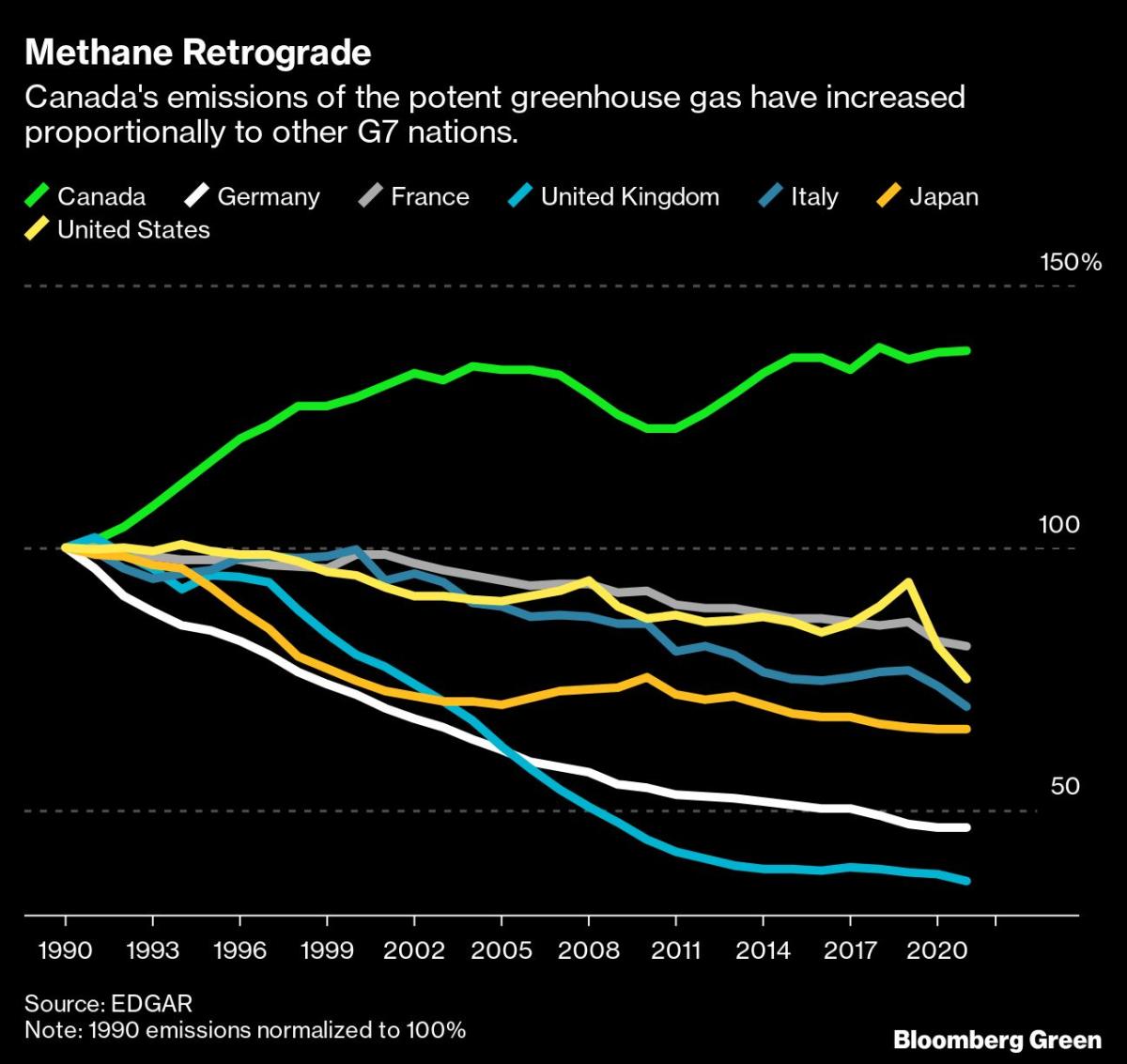
(Bloomberg) — Canadian regulators said they were unaware of a methane cloud spotted by the European Space Agency’s Sentinel-5P satellite last month near gas pipelines, highlighting a disconnect between the nation’s climate ambitions and its emissions, which are the second highest per capita among G-20 countries. Methane is a greenhouse gas about 80 times as potent in the short term as carbon dioxide.
Most Read from Bloomberg
Geoanalytics firm Kayrros SAS, which analyzed data from Sentinel-5P, identified the Sept. 28 plume. The French-based firm estimated the methane cloud had an emissions rate of 11 metric tons an hour. If the event lasted an hour at that rate, it would have the same short-term climate impact as the annual carbon emissions equivalent from about 200 US cars. Kayrros attributed the cloud to the oil and gas sector.
Both federal and local regulators said they weren’t informed of the plume, observed near the Albertan town of Lloydminster, close to the Saskatchewan-Alberta border in an area dense with oil and gas infrastructure. The Canada Energy Regulator said oil and gas operators are only required to report unintended or uncontrolled releases of methane.
The Alberta Energy Regulator, which uses a subset of Sentinel-5P data most appropriate for observing regional, persistent emitters, said the plume didn’t show up in that data. “There were no significant venting events in the area reported to the AER at that time,” said Adrian Mrdeza, an AER spokesperson, in an email. “It should be noted that elevated methane concentrations do not mean there was a non-compliance or industry related event.”
Still, the responses suggest holes in the country’s emissions reporting and tracking efforts and paint a picture at odds with the climate progress Prime Minister Justin Trudeau said his country had made in an interview with Bloomberg Green in Ottawa on Oct. 18. (You can listen to the full conversation with Trudeau on the Zero podcast on Apple, Spotify or Google.)
Trudeau said that if Canada’s oil and gas operators reduce their emissions intensity there is room for the nation to expand its production. Many climate scientists and activists argue that expanding fossil fuel output is incompatible with averting catastrophic climate change, because existing infrastructure contributes so much emissions already through intentional releases and accidental leaks.
Earth is on track to heat up between 2.1C and 2.9C by the end of the century compared to pre-industrial times and governments must accelerate efforts to cut greenhouse gas emissions to avoid the worst of global warming, scientists with the United Nations Framework Convention on Climate Change said in a report last week. Despite some progress in the last year, governments need to do more by 2030 to ensure that the global temperature increase is below 2C and ideally closer to 1.5C, the goal set in the Paris Agreement reached in 2015.
Methane generated from human activity is responsible for about a quarter of the planet’s warming and concentrations of the gas from all sources last year had the biggest year-on-year jump since measurements began four decades ago, a separate study from the World Meteorological Organization found. Methane is the primary component of natural gas and has long flown under the radar of governments in part because the colorless, odorless gas is so hard to track. But the ability to identify some of the world’s biggest leaks has changed over the past few years as new satellites with multispectral capabilities enter orbit.
Kayrros analyzed the so-called Level 2 dataset from Sentinel-5P that reflects methane concentrations from each orbit. Level 3 data, the subset used by the Alberta regulator from the same satellite, averages methane observations from multiple orbits over time. This approach can make it easier to observe persistent emitters, although it can also make intermittent emissions harder to detect.
Kayrros’ estimated location for the source of the release was within 10 kilometers of gas pipelines operated by SaskEnergy Inc. and TC Energy Corp. A spokesperson for SaskEnergy said the company didn’t have any planned or unplanned releases within a 30-kilometer radius. TC Energy declined to say if its pipeline system had any releases and the company said it doesn’t comment on third-party information. Cenovus Energy Inc., which operates an asphalt refinery in Lloydminster, said it had “no indication that our operations are the source of the methane emissions in question.”
The area in which the plume was spotted is a hub of oil and gas production and includes both active horizontal and abandoned wells, according to Kayrros. The Sept. 28 release was just the third concentration of methane identified in Canada by Kayrros this year, and the nation isn’t among a list of major oil and gas polluters in the International Energy Agency’s Methane Tracker, which identifies Russia, the US and Iran as top emitters.
Canada was an inaugural member of the Global Methane Pledge that launched in 2021 and now includes more than 120 nations that are aiming to slash global emissions of the gas from all sectors at least 30% from 2020 levels by the end of the decade. This fall, Canada announced it is aiming to reduce methane emissions more than 35% from 2020 levels by 2030. Environment minister Steven Guilbeault has said the country is on track to cut methane emissions more than 40% by 2025, relative to a 2012 baseline.
Canada’s methane and carbon dioxide releases have climbed more than any other G-7 country, relative to a 1990 baseline, according to European Commission data through early 2021. (When asked about this data, from the EC emissions database EDGAR, Bruce Cheadle, a spokesperson for the Minister of Environment and Climate Change of Canada, wrote in an email that Canadian “officials are not very familiar with EDGAR and are taking some time to better understand the methodology questions you raise.”)
Trudeau in his Oct. 18 interview defended climate action in the seven years he’s been prime minister and said the government had for the first time set a price on pollution that would continue to increase, although he acknowledged “it’s taking a while” for the impact to show up in emissions.
Bloomberg Green investigations into satellite observations of methane clouds across North America over the past year have found multiple instances in which the observations coincided with so-called pipeline blowdowns, when operators intentionally release gas directly into the atmosphere to perform inspections and maintenance. Although that practice was standard across the industry for decades, groups including the IEA have called on industry to eliminate all non-emergency venting of the gas.
Up to 90% of emissions from blowdowns can be eliminated through techniques like burning the gas through a flare and other mitigation approaches, according to a 2016 report commissioned by the Environmental Defense Fund.
Multiple studies have found methane emissions from the oil and gas industry are often higher than what operators and governments report. Releases of the gas from the US supply chain in 2015 were about 60% higher than the U.S. Environmental Protection Agency inventory estimate, a 2018 study published in Science found. Livestock, landfills and natural sources such as mud volcanoes also generate and release methane.
Most Read from Bloomberg Businessweek
©2022 Bloomberg L.P.




